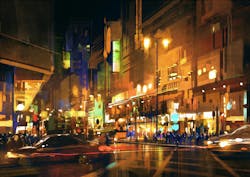Cities grapple with preventing vehicle attacks in public spaces
The Bourbon Street truck attack in New Orleans on New Year’s Day in which 14 people were killed and at least 35 injured has prompted a renewed look on how to protect pedestrians from motor vehicle attacks and accidents.
Making streets safer for pedestrians isn’t necessarily a straightforward endeavor as constituencies such as first responders and commercial building owners have objections to some solutions. For instance, a Bloomberg report points out that there can be tension between emergency services and proposed street redesigns.
Adding a protected bike lane can improve safety for both cyclists and drivers, but some first responders have objected, saying these changes can obstruct large pieces of firefighting equipment. Traffic calming features like narrower lanes and speed bumps can improve safety for pedestrians but have been blamed for delaying emergency vehicles.
Sculptural barriers designed for aesthetic interest or tree-lined buffers at the edge of gathering areas can provide protection for pedestrians in an aesthetically pleasing manner. These can be better solutions than plain concrete or metal bollards.
